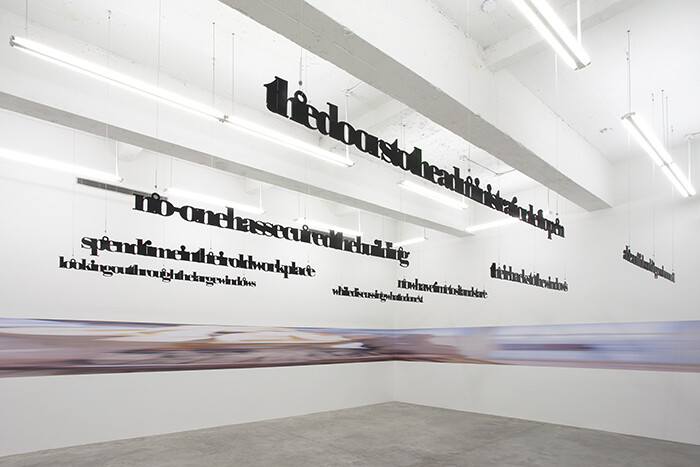In their current exhibition at Casey Kaplan, Liam Gillick and Louise Lawler look backwards and askance, mining their archives for oblique portraits of the museum and factory floors, fast inclining towards abstraction. Gillick has periodically advocated for a methodology that functions as a “critical double” and “parallel structure” to a dominant culture, and both his and Lawler’s works reveal the possibilities and pitfalls borne of such proximity.
The artists have never shown together, though each has worked to varying degrees with colleagues, from Lawler’s seminal collaborations with Sherrie Levine and Allan McCollum to Gillick’s recent exhibition with Lawrence Weiner. Lawler’s broader practice, of course, is also necessarily incorporative, filled with poignant glimpses of artworks enmeshed in institutional matrices. For Kaplan, she returns to a view of a work by Carl Andre, a Gerhard Richter color chart, and a Richard Serra drawing in Life Expectancy (2010), as well as to an image of Edgar Degas’s dancer in Chicago (2011/2012); the softness of her figure gives the tantalizing suggestion that Lawler has chosen to focus instead on the glass case so central to the sculpture’s original controversy.
These cibachromes share space with their vinyl mutations, “placed and pulled,” as she calls it, along one axis to fill the width or height of a wall. Lawler introduced a similar proviso in her 2011 exhibition at Metro Pictures, in which vinyls of works (including Life Expectancy) proportionally conformed to both given dimensions. While reading as a canny dig at the pragmatics of art collecting, the parameter yielded far limper aesthetic effects than those exhibited by the current vinyls, which exploit Kaplan’s squat galleries in order to stretch images to widths that trouble the legibility of their subjects and their very distinction, as artworks, from institutional supports.
As Lawler negotiates the wall, Gillick takes to the ceiling, re-hanging Övningskörning (Driving Practice Parts 1 - 30), a series of powder-coated, aluminum texts that were first exhibited in 2004 at the Milwaukee Art Museum. The texts plot out an ever-forthcoming book, loosely departing from the 1994 closure of a Volvo factory in Kalmar, Sweden that had served as an exemplary alternative to Fordist and Toyotist models of production—largely by incorporating worker participation into automotive planning and design. This ethos persists in the scenario described in Gillick’s piece, as former employees reoccupy the factory to improvisationally reconfigure the site and premise of work.
Gillick’s original installation extended along a corridor in Milwaukee, yielding an ambulatory form of reading through what the art historian Lilian Haberer once described as “a non-place representing a staging point for other placing.” The corridor’s ancillary relationship to the exhibition halls was an apt complement to a story about the projective and willfully provisional exertions of former workers. Much is thus lost in the three-room hanging at Kaplan, periodically compensated by Lawler’s presence, as when a text describing the characters’ enlargement of the factory windows hangs in front of her dioramic Degas vinyl, stretching to resemble bucolic vistas. At such moments, Gillick’s story of institutional reuse moves beyond merely allegorical implications, finding demonstrative support from a surprising ally.











